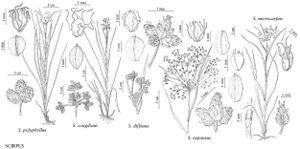Scirpus polyphyllus
Enum. Pl. 2: 274. 1805.
Plants cespitose; rhizomes short, tough, fibrous. Culms: fertile ones erect or reclining; nodes sometimes with axillary bulblets. Leaves 14–22 (–26) per culm; sheaths of proximal leaves green or brownish; proximal sheaths and blades with septa usually few, inconspicuous; blades 16–31 cm × 5–8 mm. Inflorescences terminal, rarely also with 1 lateral inflorescence from distal leaf-axil; rays divaricate, smooth throughout or scabrous distally, rays usually with axillary bulblets; bases of involucral-bracts green, not glutinous. Spikelets in dense clusters of 3–9 (largest cluster with 6 or more), spikelets sessile, broadly ovoid, 2.5–4 × 1.6–3 mm; scales reddish-brown with green midribs, circular or nearly so, 1–1.5 mm, apex mucronate or occasionally short-awned, mucro or awn 0.2–0.3 mm. Flowers: perianth bristles persistent, 6, stout, contorted, much longer than achene and projecting beyond it, retrorsely barbed in distal 1/2, exserted from scales at maturity; styles 3-fid. Achenes pale-brown, obovate or nearly obtriangular in outline, plumply trigonous or planoconvex, 1.1–1.4 (–1.8) × 0.8–1 mm. 2n = 58.
Phenology: Fruiting summer (Jul–Aug).
Habitat: Along wooded streams and other swampy places, usually shaded by trees
Elevation: 0–1000 m
Distribution

Ala., Ark., Conn., D.C., Ga., Ill., Ind., Ky., Md., Mass., Miss., Mo., N.H., N.J., N.Y., N.C., Ohio, Pa., S.C., Tenn., Vt., Va., W.Va.
Discussion
Scirpus polyphyllus occasionally hybridizes with S. atrovirens.
Selected References
None.
Lower Taxa
"shortened" is not a number.
